Trees of the Adirondacks:
Northern White Cedar (Thuja occidentalis)
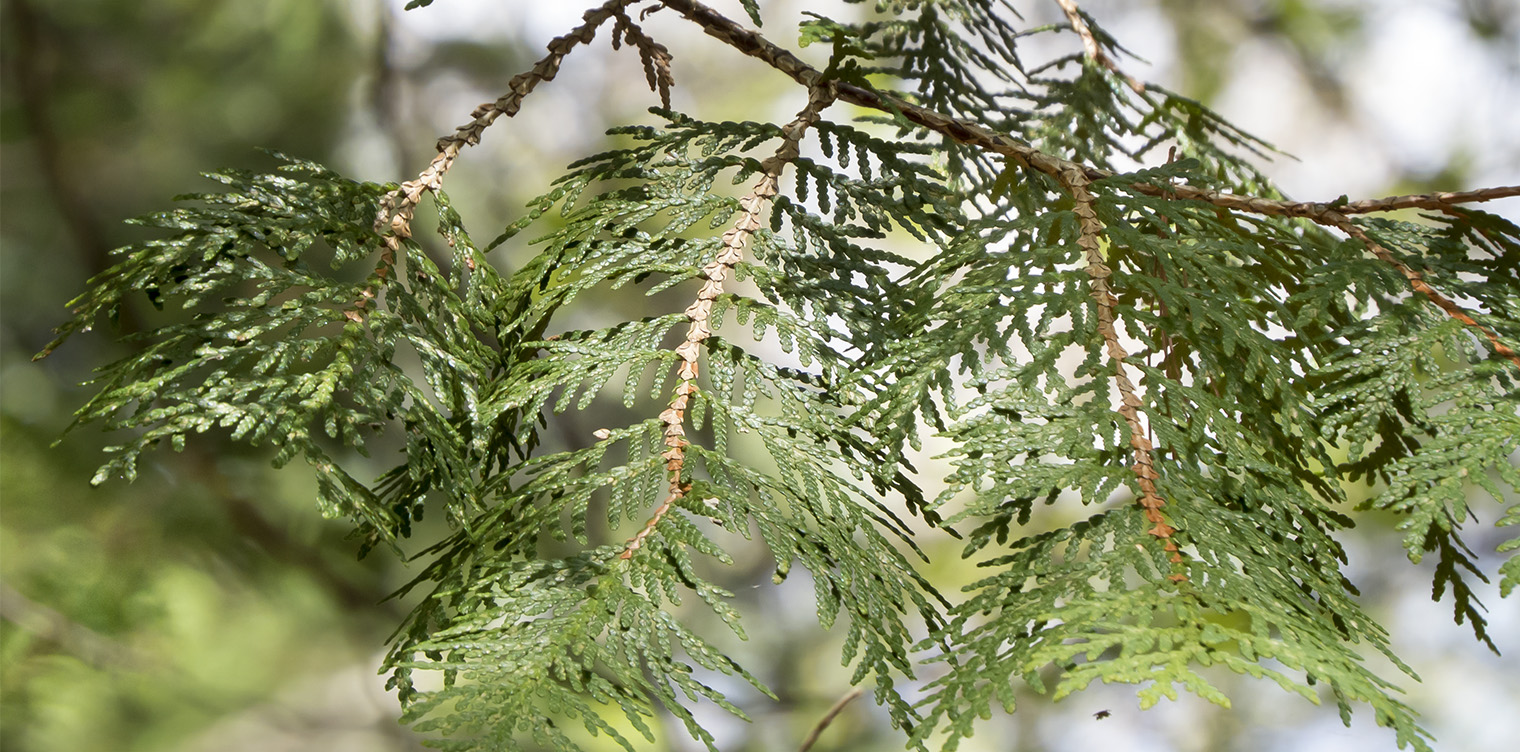
Northern White Cedar (Thuja occidentalis) is a coniferous evergreen tree with scale-like leaves. In the Adirondack Mountains, it is most abundant in wetlands and along lake shores.
Northern White Cedar is a member of the Cupressaceae family. This family also includes several other plants found in the Adirondack region, including Creeping Juniper (Juniperus horizontalis), Ground Juniper (Juniperus communis), and Eastern Red Cedar (Juniperus virginiana).
Northern White Cedar is the only member of the Thuja genus found in New York State.
- The name Thuja is said to be derived from the Greek Thuia, which is the name of a Greek juniper. The species name (occidentalis) means "western," differentiating this plant from old world plants.
- Other names for this plant include Eastern White Cedar, Eastern Thuja, Arborvitae, Arbor Vitae, American Arborvitae, and Eastern Arborvitae. Arborvitae means Tree of Life, which is a reference to the story that the vitamin C in a tea made from the foliage from this tree helped Jacques Cartier and his crew recover from scurvy in the 16th century. Northern White Cedar has also been called Swamp Cedar or Swamp-Cedar, referring to this tree's ability to thrive in wetlands.
Identification of Northern White Cedar
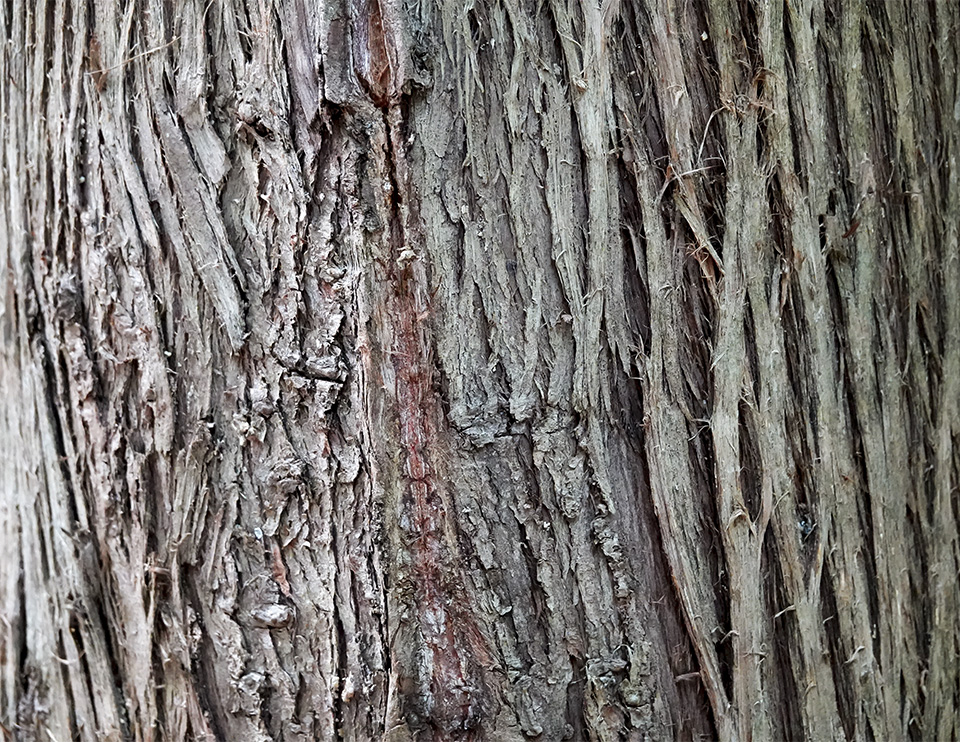
Northern White Cedar is a small to medium-sized tree. In our region, it usually grows to about 30 feet high and up to two feet in diameter. It is very slow-growing. According to Michael Kudish, who kept records of Adirondack flora in the Paul Smiths area starting in the mid-1960s, this tree shows an average increase of 12 inches in diameter per century.
The Northern White Cedar's branches are retained nearly to the ground. The crown is pyramidal in form and densely compact. The trunk is sometimes divided into two or more secondary trunks.
The bark of the Northern White Cedar is pale brown, stringy and fibrous in appearance, sometimes shredding. On young trees, the bark on the trunk is reddish brown to gray, showing thin, narrow vertical strips.
As the tree matures, the bark on the trunk becomes gray, with newly exposed bark brownish or reddish brown. The vertical strips separate from the trunk at the ends and are often oriented in a slight spiral around the trunk of the tree.
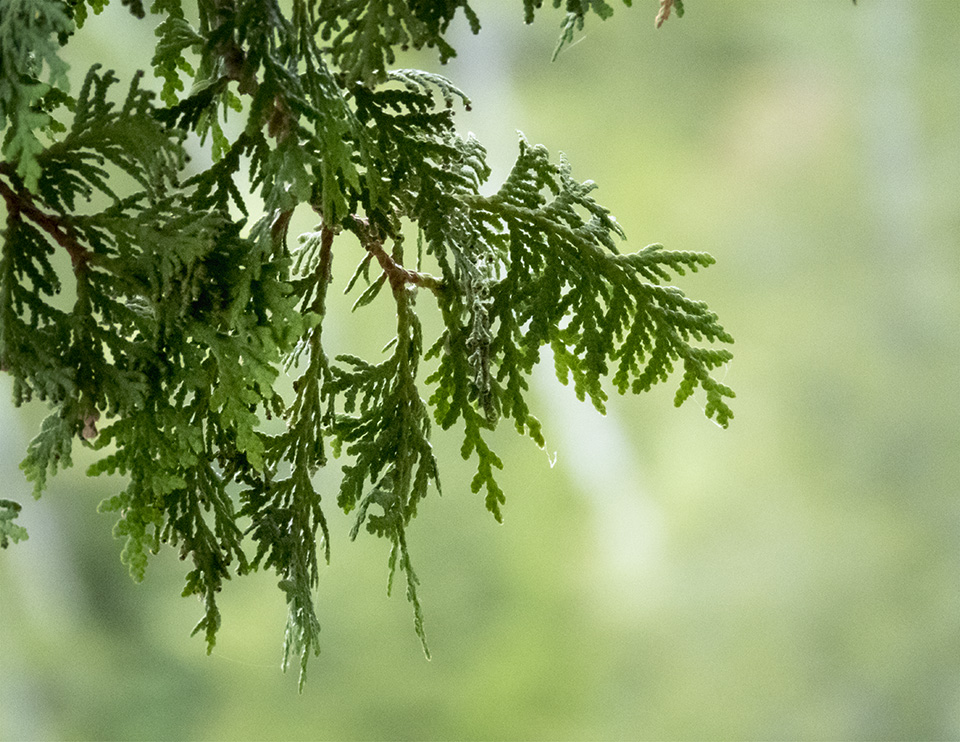
The main key to identifying Northern White Cedar is its leaf structure, which sets the tree apart from other conifers that occur in the Adirondack Park. Like other conifers found here (with the exception of the Tamarack), Northern White Cedar has evergreen leaves, but there resemblances end.
In contrast to the needles of other Adirondack conifers, Northern White Cedars have scale-like leaves arranged in tight rows along the twig, forming a flat spray. The leaves overlap and hide the twig surface. The leaves have a spicy fragrance when crushed.
Male and female flowers are tiny, cone-like bodies that are usually borne on separate twigs or branchlets. Female flowers are pinkish; they appear at the tips of the short terminal branchlets. Male flowers are yellowish and appear on branchlets near the base of the shoot.
Flower buds form during the fall. The flower buds expand in the following spring, with flowering occurring in late April and May.
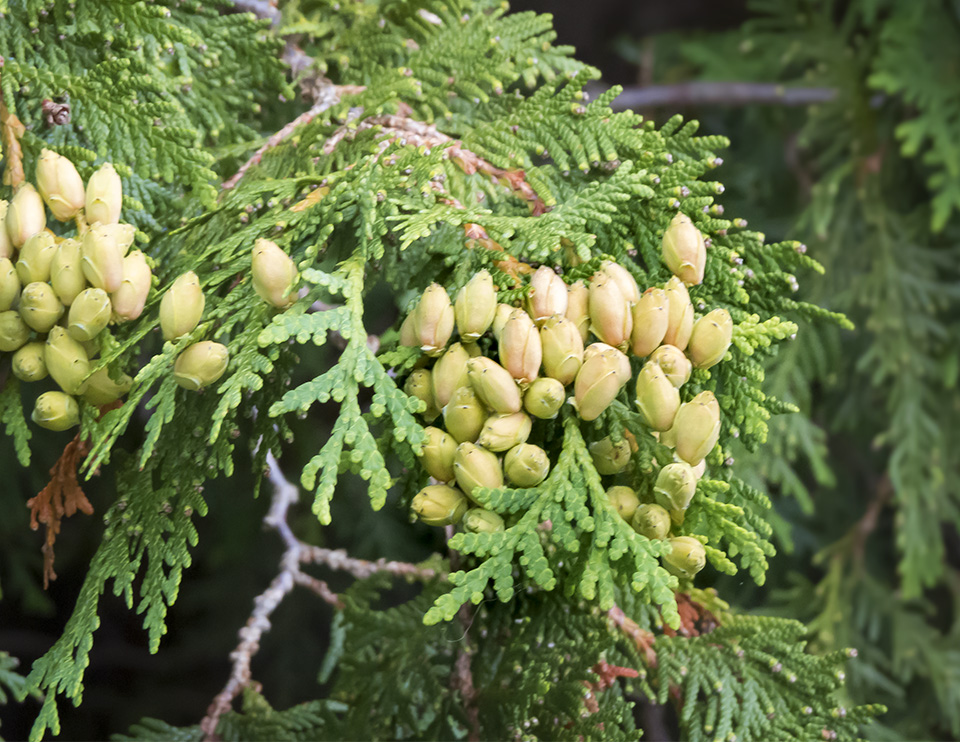
Northern White Cedar cones are egg-shaped. The pollinated conelets begin growing in late June. They ripen in late summer. The cones are ⅓ to ½ inch long. When immature, they are green or pinkish brown. The cones turn cinnamon brown at maturity.
The cone scales open in the fall to release seeds, which are light chestnut brown and flattened. The seeds are winged and about ¼ inch long. They are disseminated by the wind.
Cones appear on Northern White Cedar trees when the trees are as young as six years old, with the best seed production beginning at 75 years. Northern White Cedars reportedly bear good seed crops at intervals of two to five years.
Uses of Northern White Cedar
Northern White Cedar has a variety of human uses. The wood, which is light-weight and resistant to decay, is used to make products that come into contact with water and soil. The wood is used commercially for rustic fencing, cabin logs, poles, and shingles. The wood has also been used for paneling and boat-making. In addition, the tree is widely planted as an ornamental.
Although a tea prepared from Northern White Cedar twigs and bark was said to have saved the crew of explorer Jacques Cartier from scurvy in 1536, most sources warn against using products from this plant internally. Oil from Northern White Cedar foliage is said to be poisonous, particularly if taken in large doses.
In any event, Native American groups used Northern White Cedar for a wide variety of medical problems, including headaches, coughs, pneumonia, colds, fever, rheumatism, sprains, bruises, and sores. The Algonquin, for instance, took a decoction of branches for rheumatism. They used a poultice of powered wood for rashes and skin irritations. The branches were used in a steam bath for fevers, colds, and toothache. They also used an infusion of cones to treat babies with colic.
Native American groups also used the tree for non-medicinal purposes. The Iroquois used bark pieces as a caulking material. Other groups used the wood to make spears, basket splints, toboggans, arrows, and canoe ribs, frames, and slats.
Wildlife Value of Northern White Cedar
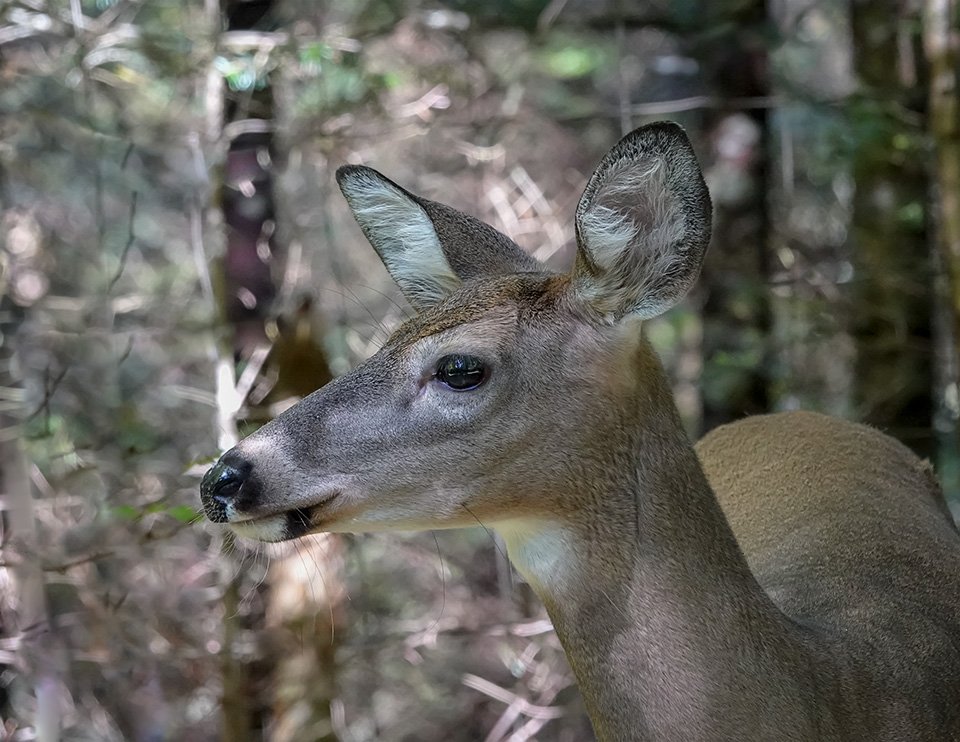
Northern White Cedar has significant value for wildlife. These trees provide food, shelter, and habitat for a wide variety of mammals and birds.
Adirondack mammals that make extensive use of Northern White Cedar include White-tailed Deer. New York State's Department of Environmental Conservation lists this plant as among the preferred or best-liked winter deer foods, based on thousands of observations in deer wintering areas over many years from all parts of the state. Northern White Cedar foliage is often over-browsed in areas where deer are abundant, resulting in deer browse lines about five feet from the ground, representing the deer's highest reach.
Twigs and foliage from Northern White Cedar reportedly constitute 10-25% of the White-tailed Deer's diet. The browse, which is high in calcium, is highly nutritious, with a composition of 28% carbohydrates and 14% crude fibers. Stands of Northern White Cedar also provide White-tailed Deer with shelter from wind and deep snow during severe winters.
Another Adirondack mammal that makes use of Northern White Cedar is the Snowshoe Hare, which feeds on the lower branches and in some cases is said to cause as much damage as that associated with deer. Most sources list Northern White Cedar as a favored browse for these hares, although one source contends that it provides only ½ to 2 percent of the hare's diet.
Other mammals that browse the foliage of Northern White Cedar include Porcupine, Red Squirrel, and American Beaver. Moose, however, are said to browse Northern White Cedar only when other food is scarce, although they may use the tree for thermal cover.
Northern White Cedar is a common tree species in the breeding habitat of a wide variety of birds, including:
American Redstart
Black-and-white Warbler
Boreal Chickadee
Canada Jay
Cedar Waxwing
Chipping Sparrow
Common Grackle
Eastern Kingbird
Evening Grosbeak
Golden-crowned Kinglet
Northern Saw-whet Owl
Pine Siskin
Tennessee Warbler
White-throated Sparrow
Winter Wren
Yellow Warbler
Yellow-rumped Warbler
Insectivorous birds often seen feeding in Northern White Cedar trees include Magnolia Warblers, Black-and-white Warblers, Pine Warblers, Black-throated Green Warblers, American Redstarts, Chipping Sparrows, White-throated Sparrows, and Hermit Thrush.
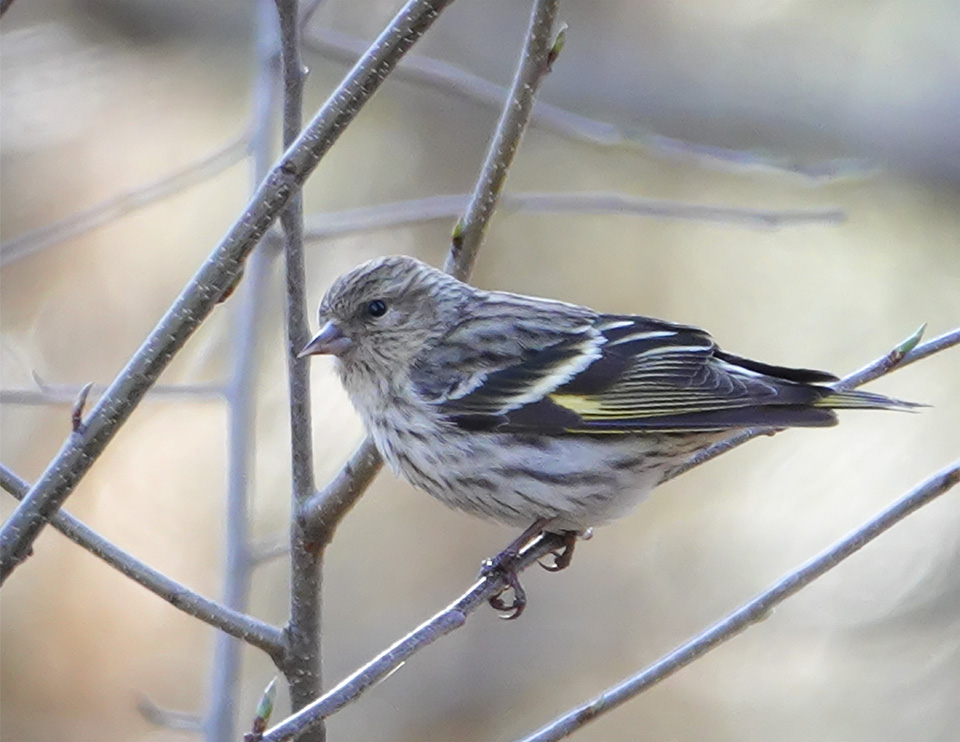
In addition, Northern White Cedar provides nesting sites for a variety of birds, including Black-and-White Warbler, American Redstart, Yellow-rumped Warbler, Cedar Waxwing, Yellow Warbler, Evening Grosbeak, Common Grackle, Eastern Kingbird, and Boreal Chickadee.
Northern White Cedar is particularly important for the Pine Siskin, for whom the seeds are a preferred source of food. According to the Martin/Zim/Nelson guide to wildlife food habits, the winged seeds of this tree constitute 10-25% of the Pine Siskin's diet in the Northeast.
Other birds make use of Northern White Cedar bark or foliage as nesting material. This includes the Swainson's Thrush, Red-tailed Hawk, and Canada Jay.
Distribution of Northern White Cedar
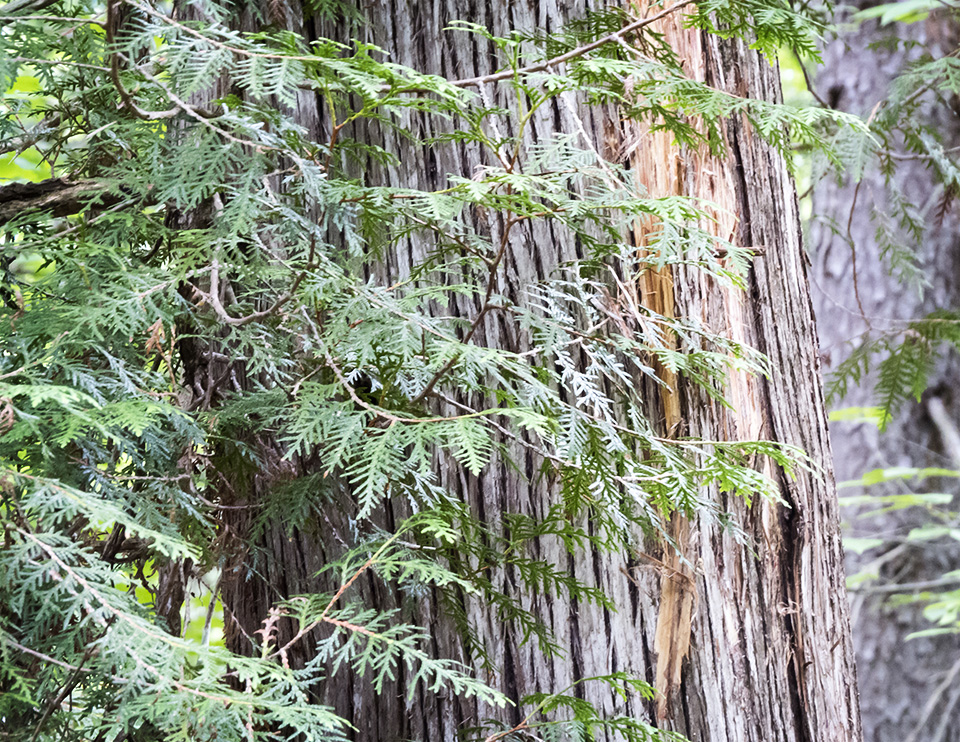
Northern White Cedar trees are found in eastern North America. Their primary range is in the southern part of the eastern half of Canada, plus the adjacent northern areas in the US, including New England, the Great Lakes states, and New York State. Scattered stands are found southward along the Appalachian Mountains into North Carolina and Tennessee.
Northern White Cedar is listed as Threatened in Connecticut, Illinois, Kentucky, and Maryland; Endangered in Indiana, Massachusetts, and New Jersey; and of special concern in Tennessee.
In New York State, Northern White Cedar has been documented in most counties, with the exception of several in the southwestern and south central areas. It is found in all counties within the Adirondack Park Blue Line.
Habitat of Northern White Cedar
Northern White Cedar is a shade-tolerant plant that can survive in a variety of soils and well to very poorly drained sites. In the Adirondack Mountains, it is most abundant in swamps, peaty bogs, and along streams and lake shores. In swamps it can form dense, almost impenetrable stands and can reach ages of 400 years or more.
In the Adirondack region, Northern White Cedars are found in a variety of ecological communities, including:
- Alpine Krummholz
- Calcareous Cliff Community
- Calcareous Pavement Woodland
- Calcareous Talus Slope Woodland
- Limestone Woodland
- Northern White Cedar Rocky Summit
- Northern White Cedar Swamp
- Red Maple-Tamarack Peat Swamp
- Rich Graminoid Fen
- Rich Hemlock-Hardwood Peat Swamp
- Rich Shrub Fen
- Silver Maple-Ash Swamp
- Spruce-Fir Swamp
Northern White Cedar is the dominant tree in the Northern White Cedar Swamp. This is a conifer or mixed swamp found on organic soils in poorly drained depressions or along lakes and streams in the northern half of New York State.
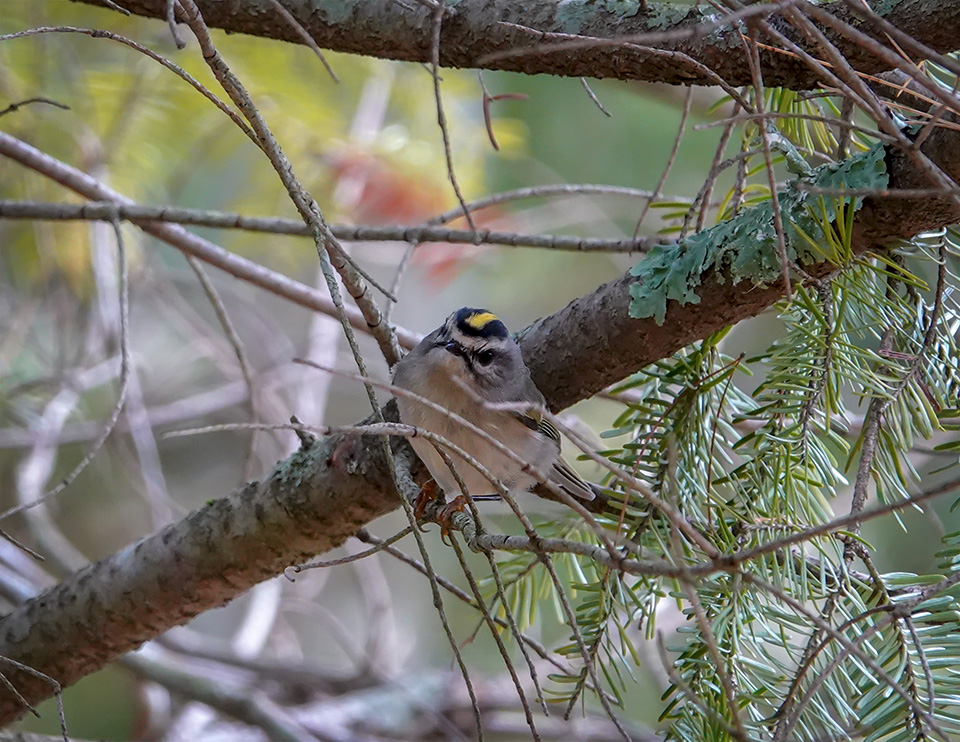
- In this community, Northern White Cedar makes up more than 30% of the canopy cover. It may form nearly pure stands or be mixed with Red Maple, Eastern Hemlock, Balsam Fir, Tamarack, Yellow Birch, Eastern White Pine, Red Spruce, or Black Spruce.
- Characteristic wildflowers found on hummocks in Northern White Cedar Swamps include Goldthread, Starflower, Bunchberry, Canada Mayflower, Clintonia, Creeping Snowberry, and Partridgeberry.
- In the hollows between hummocks you might find Cinnamon Fern and Royal Fern.
- Characteristic birds in Northern White Cedar Swamps include Northern Waterthrush, Winter Wren, White-throated Sparrow, and Golden-crowned Kinglet.
Northern White Cedar can be found along most of the trails covered here. This tree is particularly abundant along trails that traverse swampy or wetland areas or provide access to lake shores.
Adirondack Tree List
References
Michael Kudish. Adirondack Upland Flora: An Ecological Perspective (The Chauncy Press, 1992), p. 104.
E. H. Ketchledge. Forests and Trees of the Adirondack High Peaks Region (Adirondack Mountain Club, 1996), pp. 90-93.
New York Flora Association. New York Flora Atlas. Northern White Cedar. Thuja occidentalis L. Retrieved 16 January 2019.
Integrated Taxonomic Information System. Thuja occidentalis L. Retrieved 28 March 2018.
International Plant Names Index. Thuja occidentalis L. Retrieved 28 March 2018.
J. T. Kartesz. The Biota of North America Program (BONAP). 2015. Taxonomic Data Center. Chapel Hill, N.C. Thuja occidentalis. Retrieved 28 March 2018.
United States Department of Agriculture. The Plants Database. Arborvitae. Thuja occidentalis L. Retrieved 16 January 2019.
United States Department of Agriculture. NRCS National Plant Data Center & the Biota of North America Program. Plant Guide. Northern White Cedar. Thuja occidentalis L. Retrieved 28 March 2018.
Jennifer H. Carey, "Thuja occidentalis," in Fire Effects Information System (FEIS). Species Reviews. Forest Service, Rocky Mountain Research Station, Fire Sciences Laboratory (United States Department of Agriculture, 1993). Retrieved 28 March 2018.
Janet Sullivan, "Lepus americanus," in Fire Effects Information System (FEIS). Species Reviews. Forest Service, Rocky Mountain Research Station, Fire Sciences Laboratory (United States Department of Agriculture, 1995). Retrieved 28 March 2017.
Robin J. Innes, "Odocoileus virginianus," in Fire Effects Information System (FEIS). Species Reviews. Forest Service, Rocky Mountain Research Station, Fire Sciences Laboratory (United States Department of Agriculture, 2013). Retrieved 28 March 2017.
United States Department of Agriculture. Forest Service. Silvics of North America. Northern White-Cedar. Thuja occidentalis L. Retrieved 16 January 2019.
Flora of North America. Thuja occidentalis Linnaeus. Retrieved 29 March 2018.
NatureServe Explorer. Online Encyclopedia of Life. Northern White-cedar. Thuja occidentalis - L. Retrieved 29 March 2018.
Northern Forest Atlas. Images. Thuja Occidentalis. Northern White Cedar. Retrieved 16 January 2019.
Margaret B. Gargiullo. A Guide to Native Plants of the New York City Region (New York City Department of Parks & Recreation, 2007), p. 19.
New England Wildflower Society. Go Botany. Northern White-cedar. Thuja occidentalis L. Retrieved 2 April 2021.
New York State. Department of Environmental Conservation. New York Natural Heritage Program. Ecological Communities of New York State. Second Edition (March 2014), pp. 58-59, 59, 69-70, 72, 73-74, 74-75, 75-76, 93-94, 103-104, 104-105, 105-106, 107, 110-111. Retrieved 17 October 2015.
New York Natural Heritage Program. 2021. Online Conservation Guide for Alpine Krummholz. Retrieved 2 April 2021.
New York Natural Heritage Program. 2021. Online Conservation Guide for Calcareous Cliff Community. Retrieved 2 April 2021..
New York Natural Heritage Program. 2021. Online Conservation Guide for Calcareous Pavement Woodland. Retrieved 2 April 2021.
New York Natural Heritage Program. 2021. Online Conservation Guide for Calcareous Talus Slope Woodland. Retrieved 2 April 2021.
New York Natural Heritage Program. 2021. Online Conservation Guide for Limestone Woodland. Retrieved 2 April 2021.
New York Natural Heritage Program. 2021. 2019. Online Conservation Guide for Northern White Cedar Swamp. Retrieved 2 April 2021..
New York Natural Heritage Program. 2021. Online Conservation Guide for Red Maple-Tamarack Peat Swamp. Retrieved 2 April 2021.
New York Natural Heritage Program. 2021. Online Conservation Guide for Rich Graminoid Fen. Retrieved 2 April 2021.
New York Natural Heritage Program. 2021. Online Conservation Guide for Rich Hemlock-Hardwood Peat Swamp. Retrieved 2 April 2021.
New York Natural Heritage Program. 22021. Online Conservation Guide for Rich Shrub Fen. Retrieved 2 April 2021.
New York Natural Heritage Program. 2021. Online Conservation Guide for Silver Maple-Ash Swamp. Retrieved 2 April 2021.
New York Natural Heritage Program. 2021. Online Conservation Guide for Spruce-Fir Swamp. Retrieved 2 April 2021.
New York State. Adirondack Park Agency. Preliminary List of Species Native Within the Adirondack Park Listed Alphabetically by Scientific Name and Sorted by Habit. Volume 1. Updated 10.23.2006, p. 8. Retrieved 26 January 2017.
Chicago Botanic Garden. Project BudBurst. Northern White Cedar. Retrieved 29 March 2018.
University of Wisconsin. Flora of Wisconsin. Thuja occidentalis L. Retrieved 30 March 2018.
Minnesota Wildflowers. Thuja occidentalis. White Cedar. Retrieved 30 March 2018.
Illinois Wildflowers. Northern White Cedar. Thuja occidentalis. Retrieved 30 March 2018.
Illinois Wildflowers. Vertebrate Animal & Plant Database. Thuja occidentalis. Eastern White Cedar. Retrieved 30 March 2018.
Illinois Wildflowers. Plant-Feeding Insect Database. Thuja occidentalis. Northern White Cedar. Retrieved 30 March 2018.
Eloise Butler Wildflower Garden. The Friends of the Wild Flower Garden. Northern White Cedar. Thuja occidentalis L. Retrieved 30 March 2018.
Lady Bird Johnson Wildflower Center. Thuja occidentalis. Retrieved 30 March 2018.
New York State Department of Environmental Conservation. Winter Deer Foods. Retrieved 30 March 2018.
iNaturalist. Thuja occidentalis. Retrieved 30 March 2018.
William K. Chapman and Alan E. Bessette. Trees and Shrubs of the Adirondacks: A Field Guide (North Country Books, 1990), p. 20, Plate 3.
Stan Tekiela. Trees of New York: Field Guide (Adventure Publications, Inc., 2006), pp. 34-35.
Michael Wojtech. Bark: A Field Guide to Trees of the Northeast (University Press of New England, 2011), pp. 124-125.
George A. Petrides. A Field Guide to Eastern Trees (Boston: Houghton Mifflin Company, 1998), pp. 42-43, 181-182.
Gil Nelson, Christopher J. Earle, and Richard Spellenberg. Trees of Eastern North America (Princeton University Press, 2014), p. 50.
C. Frank Brockman. Trees of North America: A Field Guide to the Major Native and Introduced Species North of Mexico (New York: Golden Press, 1986), pp. 54-55.
Alan Mitchell. The Trees of North America (Facts on File Publications, 1987), pp. 136-137.
R. C. Hosie. Native Trees of Canada. 8th Edition (Canada. Department of Forestry and Rural Development, 1979), pp. 98-99. Retrieved 30 March 2018.
Charles W. Johnson. Bogs of the Northeast (University Press of New England, 1985), pp. 29, 58, 126, 168, 192.
John Kricher. A Field Guide to Eastern Forests. North America (Boston: Houghton Mifflin, 1998), p. 59.
Michael D. Williams, "Arborvitae, Thuja occidentalis," in Identifying Trees of the East: An All-Season Guide to Eastern North America. 2nd Edition. (Stackpole Books, 2017) Kindle Edition. Retrieved 4 April 2018.
David Allen Sibley. The Sibley Guide to Trees (New York: Alfred A. Knopf, 2009), p. 70.
William Carey Grimm. The Illustrated Book of Trees (Stackpole Books, 2002), pp. 169-171.
Allen J. Coombes. Trees (Dorling Kindersley, Inc., 1992), p. 49.
Alexander C. Martin, Herbert S. Zim, and Arnold L. Nelson. American Wildlife & Plants. A Guide to Wildlife Food Habits (Dover Publications, 1951), p. 294. Retrieved 18 January 2019.
John Eastman. The Book of Swamp and Bog: Trees, Shrubs, and Wildflowers of Eastern Freshwater Wetlands (Stackpole Books, 1995), pp. 47-51.
John Eastman. The Book of Forest and Thicket: Trees, Shrubs, and Wildflowers of Eastern North America (Stackpole Books, 1992), pp. 49-51.
John Eastman, " Pileated Woodpecker," The Eastman Guide to Birds: Natural History Accounts for 150 North American Species. Kindle Edition. (Stackpole Books, 2012).
John Eastman, "Red-tailed Hawk," The Eastman Guide to Birds: Natural History Accounts for 150 North American Species. Kindle Edition. (Stackpole Books, 2012).
John Eastman, "Golden-crowned and Ruby-crowned Kinglets," The Eastman Guide to Birds: Natural History Accounts for 150 North American Species. Kindle Edition. (Stackpole Books, 2012).
John Eastman, "Eastern Kingbird," The Eastman Guide to Birds: Natural History Accounts for 150 North American Species. Kindle Edition. (Stackpole Books, 2012).
Richard M. DeGraaf. Trees, Shrubs, and Vines for Attracting Birds. Second Edition. Revised (University Press of New England, 2002). pp. 62-64. Retrieved 4 March 2018.
Donald Culross Peattie. A Natural History of Trees of Eastern and Central North America (Houghton Mifflin Company, 1966), pp. 65-68. Retrieved 4 March 2018.
Margaret McKenny. Birds in the Garden (Grosset & Dunlap, 1939), p. 235.
Verne E. Davison. Attracting Birds: from the Prairies to the Atlantic (Thomas Y. Crowell Company, 1967), p. 222.
Plants for a Future. Thuja occidentalis. Retrieved 16 January 2019.
Steven Foster and James A. Duke. A Field Guide to Medicinal Plants and Herbs of Eastern and Central North America. Third Edition. (Houghton Mifflin Harcourt, 2014), pp. 344-345.
Bradford Angier. Field Guide to Edible Wild Plants. Revised and Updated. (Stackpole Books, 2008), pp. 10-11.
University of Michigan. Native American Ethnobotany. A Database of Foods, Drugs, Dyes and Fibers of Native American Peoples, Derived from Plants. Eastern Arborvitae. Thuja occidentalis L. Retrieved 31 March 2018.
The Cornell Lab of Ornithology. Birds of North America. Subscription web site. Black-and-White Warbler, American Redstart, Yellow-rumped Warbler, Cedar Waxwing, Yellow Warbler, Evening Grosbeak, Common Grackle, Eastern Kingbird, Boreal Chickadee, Gray Jay, Chipping Sparrow, American Goldfinch, Northern Saw-whet Owl, White-throated Sparrow, Winter Wren, Tennessee Warbler, Pine Siskin, Golden-crowned Kinglet. Retrieved 31 March 2018.
Iowa State University. BugGuide. Argyresthia thuiella, Phloeosinus canadensis, Dichomeris setosella, Argyresthia canadensis, Sparganothis tristriata, Amorbia humerosana, Patalene olyzonaria. Retrieved 31 March 2018.
Meiyin Wu & Dennis Kalma. Wetland Plants of the Adirondacks: Ferns, Woody Plants and Graminoids (Trafford Publishing, 2011), p. 27.
Ronald B. Davis. Bogs & Fens. A Guide to the Peatland Plants of the Northeastern United States and Adjacent Canada (University Press of New England, 2016), pp. 46-47.
Allen J. Coombes. Dictionary of Plant Names (Timber Press, 1994), p. 181.
P.M. Eckel A Grammatical Dictionary of Botanical Latin. Thuja. (Missouri Botanical Garden, 2011). Retrieved 16 January 2019.
Charles H. Peck. Plants of North Elba. (Bulletin of the New York State Museum, Volume 6, Number 28, June 1899). p. 128. Retrieved 22 February 2017.
Jesse E. H. Patterson, Stephen J. Patterson, and Ray J. Malcolm, "Cavity Nest Materials of Northern Flying Squirrels, Glaucomys sabrinus, and North American Red Squirrels, Tamiasciurus hudsonicus, in a Secondary Hardwood Forest of Southern Ontario," The Canadian Field-Naturalist, Volume 121, Number 3 (2001), pp. 303-307. Retrieved 31 March 2018.
Linh P. Nguyen, Josef Hamr, and Glenn H. Parker, "Wild Turkey, Meleagris gallopavo silvestris, Behavior in Central Ontario During Winter," The Canadian Field-Naturalist, Volume 118, Number 2 (2004), pp. 251-255 . Retrieved 31 March 2018.
Shaler E. Aldous, "Deer Browse Clipping Study in the Lake States Region," The Journal of Wildlife Management, Volume 16, Number 4 (October 1952), pp. 401-409. Retrieved 31 March 2018.
D. E. Ullrey, W. G. Youatt, H. E. Johnson, P. K. Ku and L. D. Fay, "Digestibility of Cedar and Aspen Browse for the White-Tailed Deer," The Journal of Wildlife Management, Volume 28, Number 4 (October 1964), pp. 791-797. Retrieved 31 March 2018.
Philip V. Hofmeyer, Laura S. Kenefic, and Robert S. Seymour, "Northern White-Cedar Ecology and Silviculture in the Northeastern United States and Southeastern Canada: A Synthesis of Knowledge," Northern Journal of Applied Forestry, Volume 26, Number 1 (2009), pp. 21-27. Retrieved 31 March 2018.
James D. Curtis, "Preliminary Observations on Northern White Cedar in Maine," Ecology, Volume 27, Number 1 (January 1946), pp. 23-36. Retrieved 31 March 2018.
Lauritis W. Krefting. The Effect of White-Tailed Deer and Snowshoe Hare Browsing on Trees and Shrubs in Northern Minnesota. Minnesota Agricultural Experiment Station, 1975. Retrieved 31 March 2018.
Deanna K. Dawson, "Bird Communities Associated with Succession and Management of Lowland Conifer Forests," in Richard M. DeGraaf and Keith E. Evans (eds.). Management of North Central and Northeastern Forests for Nongame Birds: Workshop Proceedings, pp. 120-131. (USDA Forest Service, General Technical Report NC-51. North Central Forest Experiment Station, St. Paul, MN, 1979), pp. 120-131. Retrieved 16 January 2019.
